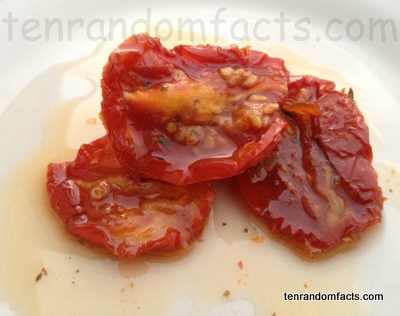The most natural dried tomatoes are sun-dried tomatoes.
- Sun-dried tomatoes are tomatoes that lack significant water content due to being dried via the sun, and it is the preferred method of drying tomatoes.
- ‘Sun-dried tomatoes’ are also known as ‘sun dried tomatoes’ and ‘sundried tomatoes’, and the practice of drying tomatoes in the sun was originally done on roof riles and most likely originated in Italy, in Europe, for the purpose of preserving the tomatoes for use during winter.
- Sun-dried tomatoes, prior to drying, are often salted, or gassed with sulphur dioxide, which improves the colour of the tomatoes and acts as a preservative.
- Tomatoes usually need exposure to the sun for 4 to 10 days to become sun-dried tomatoes, and they will only weigh approximately 10% of their original weight.
- Sun-dried tomatoes range in texture, colour, and size, along with the tomato variety used, and red plum tomatoes, like Roma tomatoes, are the most common tomato variety used.
- Sun-dried tomatoes usually have a deeper and richer flavour than fresh tomatoes, and often contain extra flavouring, additives or preservatives.
- The top producer of sun-dried tomatoes is said to be Europe’s Turkey, producing 40% of the world’s production.
- Sun-dried tomatoes can be used in, but not limited to, main dishes, baking, salads, and sauces.
- Sun-dried tomatoes can be bought raw, as a paste, or bottled in oil with herbs and are commonly available in jars in supermarkets.
- Sun-dried tomatoes are very high in potassium, sodium, and manganese and are high in vitamin C, niacin, vitamin K, iron, copper, and fibre, and they have significant quantities of other vitamins and minerals.
Bibliography:
Sun-dried Tomato, 2014, Wikipedia, http://en.wikipedia.org/wiki/Sun-dried_tomato
Sundried Tomatoes, 2004, Bedemco Inc., http://www.bedemco.com/vegetables/sun_tom.htm






